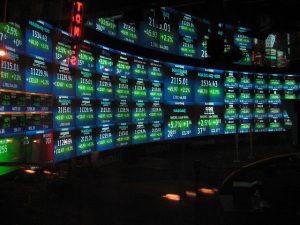This report is not a personal recommendation and does not take into account your personal circumstances or appetite for risk.
 All Tech stocks may seem equal. But some are more equal than others. The recent US tech rally produced some spectacular equity gains, but the latest corporate results may have finally separated the wheat from the chaff. Here’s how we separated them.
All Tech stocks may seem equal. But some are more equal than others. The recent US tech rally produced some spectacular equity gains, but the latest corporate results may have finally separated the wheat from the chaff. Here’s how we separated them.
By now, everyone must have heard about Facebook’s embarrassing 19% ‘face-plant’ that wiped out $120bn in corporate value, about equivalent to the entire market cap of Royal Dutch Shell (5% of the UK 100 ). But where does this reaction come from? For Facebook, outlook is key.
The social network didn’t just announce slower future earnings growth, but now expects revenue to decline (sic!) for the remainder of the year. Not a pleasant message for shareholders.
By comparison, Amazon’s Q2 results couldn’t be more different. Yes, there was a slight 1% consensus miss on revenues ($52.9bn vs. $53.4bn projections, but what’s $500m between friends?), but the online retailer comfortably beat profits expectations, delivering $2.5bn in second quarter, 12 times higher since same time last year, while operating margins of 5.6% easily beat 3.2% analyst expectations, confirming strong profitability.
The strong message on margins and profitability led investors to reward Amazon shares with a 3% rise in after-market trading, putting it firmly on the path to becoming the first $1 trillion (yes, with a T; a thousand billion, a million million) company.
FAANG has become a popular acronym for the fast-growing US tech superstars but the aforementioned duo (the “F” and the “A”) could not be looking more contrasting as we move into the second half of the year.
So, how can we differentiate between these tech giants? FAANGs are obviously not all alike and the cool name doesn’t necessarily make sense when their results diverge so radically, and perhaps their products and services do too. Should we not differentiate their business models? The likes of Amazon, Apple and Alphabet sell tangible things, stuff we can touch and hold. Whether its dishwashers or mobile phones or cloud computing services, these things can be bought by customers repeatedly, forever.
But social networks like Facebook or Twitter (yes, Donald Trump’s favourite medium of communications also missed profits expectation!) sell their users’ “attention”. As the saying goes, “when the product is free, you are the product”. Social networks sell their subscriber counts and the times that their users look at ads. And that time is limited both by the number of people on this planet and number of hours in a day. We can own two iPhones, but can we really use Twitter twice as much? This potentially limits the commercial value of social networks over the long term. Once you are subscribed, you are subscribed, so growth will eventually slow.
Perhaps the FAANG grouping is unfair, and there should, in fact, be two very distinct groups of internet/tech companies, one side dominating the intangible/social consumption (social media & entertainment), the other side focused on the tangible (e-commerce & devices).
The Nasdaq, where all these companies trade, is constantly pushing ever higher, 29 new highs recorded year-to-date (double the next best major index, the Dow). But investing in diversified indices may limit the full potential for maximising return on investments.
For Tech stock aficionados, real edge comes not from investing in all of Nasdaq, or all FAANGs, but in carefully selecting the real leaders and laggards in the new competitive environment. And that means doing what we here at Accendo Markets do every day: reading analyst previews, analysing companies’ business models and looking for technical support & resistance levels that can give investors a trading edge.
If you have an opinion on where the Nasdaq and Tech stocks will go for the rest of the year and see a trading opportunity, we can always discuss your investment/trading options. You can easily get in touch with me by clicking here to access our research and trade ideas.
Amrit Panesar, Senior Trader at Accendo Markets, 27 July 2018
This research is produced by Accendo Markets Limited. Research produced and disseminated by Accendo Markets is classified as non-independent research, and is therefore a marketing communication. This investment research has not been prepared in accordance with legal requirements designed to promote its independence and it is not subject to the prohibition on dealing ahead of the dissemination of investment research. This research does not constitute a personal recommendation or offer to enter into a transaction or an investment, and is produced and distributed for information purposes only.
Accendo Markets considers opinions and information contained within the research to be valid when published, and gives no warranty as to the investments referred to in this material. The income from the investments referred to may go down as well as up, and investors may realise losses on investments. The past performance of a particular investment is not necessarily a guide to its future performance.
Prepared by Michael van Dulken, Head of ResearchComments are closed.